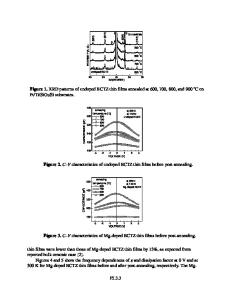Structure and Property Characterization of Porous Low-k Dielectric Constant Thin Films using X-ray Reflectivity and Smal
- PDF / 212,158 Bytes
- 8 Pages / 612 x 792 pts (letter) Page_size
- 44 Downloads / 360 Views
Structure and Property Characterization of Porous Low-k Dielectric Constant Thin Films using X-ray Reflectivity and Small Angle Neutron Scattering Eric K. Lin, Wen-li Wu, Changming Jin1, and Jeffrey T. Wetzel1 Polymers Division, Materials Science and Engineering Laboratory, National Institute of Standards and Technology 100 Bureau Drive, Stop 8541, Gaithersburg, MD 20899-8541 USA 1 SEMATECH 2706 Montopolis Drive, Austin, TX 78741-6499 USA ABSTRACT High-resolution X-ray reflectivity and small angle neutron scattering measurements are used as complementary techniques to characterize the structure and properties of porous thin films for use as low-k interlevel dielectric (ILD) materials. With the addition of elemental composition information, the average pore size, porosity, pore connectivity, matrix density, average film density, film thickness, coefficient of thermal expansion, and moisture uptake of porous thin films are determined. Examples from different classes of materials and two analysis methods for small angle neutron scattering data are presented and discussed. INTRODUCTION With decreasing feature sizes, next generation integrated circuits require materials with lower dielectric constants. A lower dielectric constant is needed to increase signal propagation speed, reduce power consumption, and to reduce crosstalk between adjacent conducting lines. One strategy to lower the dielectric constant is the incorporation of nanometer scale pores into a solid dielectric material [1,2]. The voids in the film effectively reduce the overall dielectric constant of the material. Although the introduction of voids effectively lowers the dielectric constant, other properties required for successful integration into devices including thermal, chemical, adhesive, electrical, and mechanical properties may suffer with the introduction of voids into the film. Unlike conventional fully dense dielectric materials, structural information such as the film porosity, connectivity, and pore size distribution is needed to understand and improve other critical properties of the material. Structural information as a function of processing methods and processing parameters provides materials engineers information needed to optimize these properties. The measurement of structural and material properties of porous low-k dielectric films is challenging because the films are typically 1 µm thick and must be characterized as prepared on a silicon substrate. To date, several experimental methodologies have been developed to characterize the structure of porous low-k dielectric thin films. Gidley et al. use positronium annihilation lifetime spectroscopy to measure the average pore size and pore size distribution of porous low-k thin films [3]. Dultsev and Baklanov use ellipsometric porosimetry to also determine the average pore size and pore size distribution [4]. Wu et al. at the National Institute of Standards and Technology (NIST) use a combination of high resolution specular X-ray reflectivity (SXR) and small angle neutron scattering (SANS) to
Data Loading...









